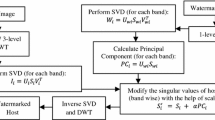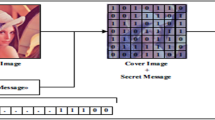Abstract
The development of the internet offers the ability to transmit large amounts of data quite conveniently via networks. However, sensitive data in transmission can easily be intercepted by unknown persons or hackers on the internet. Steganography techniques are thus needed to protect the information being transmitted over the internet. In this paper, a new efficient method based on the artificial bee colony (ABC) approach is proposed to enhance LSB based image steganography. The ABC is employed to optimize the block assignment for embedding a secret image into a host image. However, this block assignment is considered as a combinatorial optimization problem, but the ordinary ABC algorithm is designed to solve numerical optimization problems. A block assignment list, which is used to represent the solutions in the ABC algorithm, is thus introduced and the solution updating process in the ABC based on the block assignment list is also presented in this work. Experimental results demonstrate that the stego image obtained by the proposed method is not only of good quality, but is also able to tolerate certain noise attacks when compared with other recent data hiding techniques in the spatial domain. In addition, the advantage of this proposed method is that it embeds the corresponding block of a secret image into each block of the host image with permutation. Thus, the secret image cannot be recovered from the stego image without knowing this permutation.








Similar content being viewed by others
References
Bailey K, Curran K (2006) An evaluation of image based steganography methods using visual inspection and automated detection techniques. Multimedia Tools and Applications 30:55–88
Banharnsakun A (2017) A MapReduce-based artificial bee colony for large-scale data clustering. Pattern Recogn Lett 93:78–84
Banharnsakun A (2017) Hybrid ABC-ANN for pavement surface distress detection and classification. Int J Mach Learn Cybern 8(2):699–710
Banharnsakun A, Tanathong S (2014) Object detection based on template matching through use of best-so-far ABC. Computational intelligence and neuroscience 2014:article 7
Banharnsakun A, Achalakul T, Batra RC (2012) Target finding and obstacle avoidance algorithm for microrobot swarms. In: proceedings of the 2012 I.E. International Conference on Systems, Man, and Cybernetics, pp. 1610–1615
Banoci V, Bugar G, Levicky D (2011) A novel method of image steganography in DWT domain. In: Proceedings of the 21st International Conference Radioelektronika (RADIOELEKTRONIKA), pp. 1–4
Bedi P, Bansal R, Sehgal P (2013) Using PSO in a spatial domain based image hiding scheme with distortion tolerance. Comput Electr Eng 39:640–654
Chan C-K, Cheng LM (2004) Hiding data in images by simple LSB substitution. Pattern Recogn 37:469–474
Chandramouli R, Kharrazi M, Memon N (2003) Image Steganography and Steganalysis: Concepts and Practice. In: Proceedings of International Workshop on Digital Watermarking, pp. 35–49
Chanu YJ, Tuithung T, Singh KM (2012) A short survey on image steganography and steganalysis techniques. In: Proceedings of the 3rd National Conference on Emerging Trends and Applications in Computer Science (NCETACS), pp. 52–55
Cheddad A, Condell J, Curran K, Kevitt PM (2010) Digital image steganography: survey and analysis of current methods. Signal Process 90:727–752
Forczmański P, Węgrzyn M (2009) Open virtual steganographic laboratory, In: Proceedings of International Conference on Advanced Computer Systems (ACS-AISBIS, 2009), pp. 60–65
Hsu C-S, Tu S-F (2010) Finding optimal LSB substitution using ant colony optimization algorithm. In: proceeding of Second International Conference on Communication Software and Networks, pp. 293–297
Karaboga D, Gorkemli B, Ozturk C, Karaboga N (2012) A comprehensive survey: artificial bee colony (ABC) algorithm and applications. Artif Intell Rev 42:21–57
Katzenbeisser S, Petitcolas F (2000) Information hiding techniques for steganography and digital watermarking. ArtechHouse, Inc., Norwood
Li B, He J, Huang J, Shi YQ (2011) A survey on image steganography and steganalysis. Journal of Information Hiding and Multimedia Signal Processing 2:142–172
Lin C-C, Shiu P-F (2010) High capacity data hiding scheme for DCT-based images. Journal of Information Hiding and Multimedia Signal Processing 1:220–240
Lin I-C, Lin Y-B, Wang C-M (2009) Hiding data in spatial domain images with distortion tolerance. Computer Standards & Interfaces 31:458–464
Nickfarjam AM, Azimifar Z (2012) Image steganography based on pixel ranking and particle swarm optimization. In: Proceedings of the 16th CSI International Symposium on Artificial Intelligence and Signal Processing, pp. 360–363
Noda H, Niimi M, Kawaguchi E (2006) High-performance JPEG steganography using quantization index modulation in DCT domain. Pattern Recogn Lett 27:455–461
Sadek MM, Khalifa AS, Mostafa MGM (2015) Video steganography: a comprehensive review. Multimedia Tools and Applications 74:7063–7094
Subhedar MS, Mankar VH (2014) Current status and key issues in image steganography: a survey. Computer Science Review 13-14:95–113
Wang R-Z, Lin C-F, Lin J-C (2001) Image hiding by optimal LSB substitution and genetic algorithm. Pattern Recogn 34:671–683
Węgrzyn M (2017) Virtual steganographic laboratory for digital images (VSL) free tool for steganography and steganalysis, Sourceforge. http://vsl.sourceforge.net/index.htm. Accessed 2 Sept 2017
Xie X, Livermore C (2016) A pivot-hinged, multilayer SU-8 micro motion amplifier assembled by a self-aligned approach. In: proceedings of the IEEE 29th International Conference on Micro Electro Mechanical Systems (MEMS 2016), pp. 75–78
Xie X, Livermore C (2017) Passively self-aligned assembly of compact barrel hinges for high-performance, out-of-plane mems actuators. In: proceedings of the IEEE 30th International Conference on Micro Electro Mechanical Systems (MEMS 2017), pp. 813–816
Xie X, Zaitsev Y, Velásquez-García L, Teller SJ, Livermore C (2014) Compact, scalable, high-resolution, MEMS-enabled tactile displays. In: proceedings of Solid-State Sensors, Actuators, and Microsystems Workshop, pp. 127–130
Xie X, Zaitsev Y, Velásquez-García LF, Teller SJ, Livermore C (2014) Scalable, MEMS-enabled, vibrational tactile actuators for high resolution tactile displays. J Micromech Microeng 24:125014
Yu Y-H, Chang C-C, Lin I-C (2007) A new steganographic method for color and grayscale image hiding. Comput Vis Image Underst 107:183–194
Yuefen C, Junhuan L, Caiming C, Shingqing Z (2010) Image hiding based on intensity quantization using genetic algorithm. In: Proceedings of International Conference On Computer and Communication Technologies in Agriculture Engineering (CCTAE), pp. 308–310
Acknowledgments
This work is partially supported by the Faculty of Engineering at Sriracha, Kasetsart University Sriracha Campus (2560/1).
Author information
Authors and Affiliations
Corresponding author
Rights and permissions
About this article
Cite this article
Banharnsakun, A. Artificial bee colony approach for enhancing LSB based image steganography. Multimed Tools Appl 77, 27491–27504 (2018). https://doi.org/10.1007/s11042-018-5933-5
Received:
Revised:
Accepted:
Published:
Issue Date:
DOI: https://doi.org/10.1007/s11042-018-5933-5




